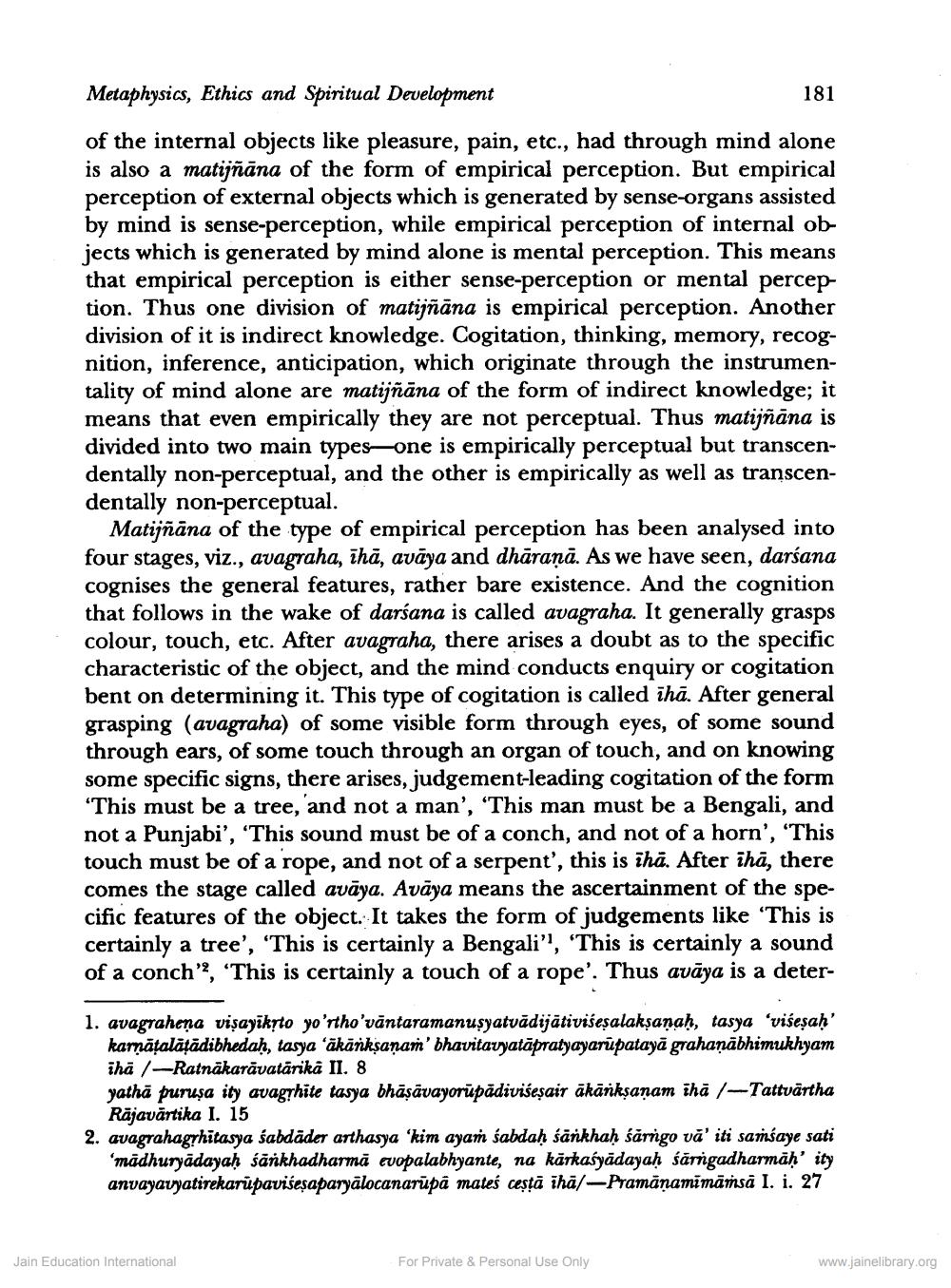________________
Metaphysics, Ethics and Spiritual Development
of the internal objects like pleasure, pain, etc., had through mind alone is also a matijñāna of the form of empirical perception. But empirical perception of external objects which is generated by sense-organs assisted by mind is sense-perception, while empirical perception of internal objects which is generated by mind alone is mental perception. This means that empirical perception is either sense-perception or mental perception. Thus one division of matijñāna is empirical perception. Another division of it is indirect knowledge. Cogitation, thinking, memory, recognition, inference, anticipation, which originate through the instrumentality of mind alone are matijñāna of the form of indirect knowledge; it means that even empirically they are not perceptual. Thus matijñāna is divided into two main types-one is empirically perceptual but transcendentally non-perceptual, and the other is empirically as well as transcendentally non-perceptual.
Matijñāna of the type of empirical perception has been analysed into four stages, viz., avagraha, ihā, avaya and dhāraṇā. As we have seen, darśana cognises the general features, rather bare existence. And the cognition that follows in the wake of darśana is called avagraha. It generally grasps colour, touch, etc. After avagraha, there arises a doubt as to the specific characteristic of the object, and the mind conducts enquiry or cogitation bent on determining it. This type of cogitation is called ihā. After general grasping (avagraha) of some visible form through eyes, of some sound through ears, of some touch through an organ of touch, and on knowing some specific signs, there arises, judgement-leading cogitation of the form "This must be a tree, and not a man', "This man must be a Bengali, and not a Punjabi', 'This sound must be of a conch, and not of a horn', "This touch must be of a rope, and not of a serpent', this is iha. After ihā, there comes the stage called avāya. Avaya means the ascertainment of the specific features of the object. It takes the form of judgements like 'This is certainly a tree', 'This is certainly a Bengali', 'This is certainly a sound of a conch", "This is certainly a touch of a rope'. Thus avāya is a deter
1. avagrahena viṣayikṛto yo'rtho'vāntaramanuṣyatvādijātivišeṣalakṣaṇaḥ, tasya 'viseṣaḥ' karṇāṭalātādibhedaḥ, tasya 'äkänkṣaṇam' bhavitavyatapratyayarupatayā grahaṇābhimukhyam iha/-Ratnakarāvatärikä II. 8
181
yatha puruşa ity avagṛhite tasya bhāṣāvayorupādiviseṣair ākānkṣaṇam ihā /-Tattvärtha Rājavārtika I. 15
2. avagrahagṛhitasya sabdader arthasya 'kim ayaṁ śabdaḥ śānkhaḥ śārngo va' iti samśaye sati 'mādhuryadayaḥ śānkhadharmā evopalabhyante, na kārkasyādayaḥ śārngadharmāḥ' ity anvayavyatirekarupaviseṣaparyālocanarupā mateś ceṣṭā iha/-Pramāṇamimämsä I. i. 27
Jain Education International
For Private & Personal Use Only
www.jainelibrary.org




